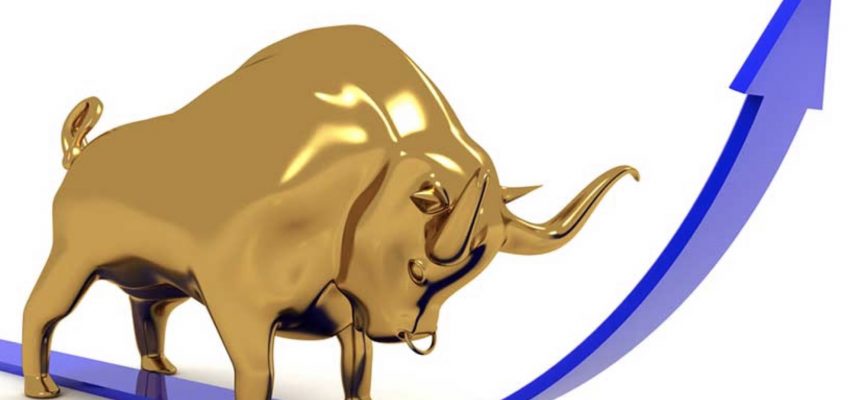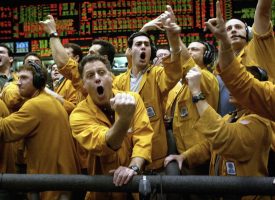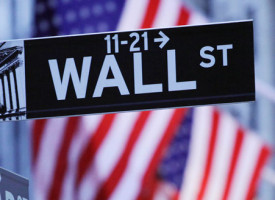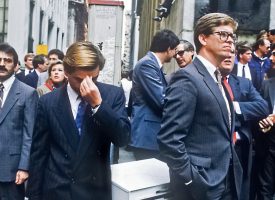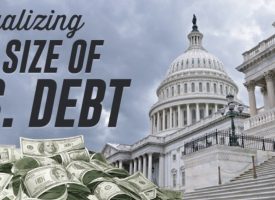Today a legend who is connected in China at the highest levels predicted the price of gold is going to surge another $700.
US Money Supply Up A Staggering 300%
By John Ing, Maison Placements
August 20 (King World News) – US money supply is up almost a whopping 300 percent from 2008. In this artificial environment of zero interest rates and zero return, instead of funding productive investments, what essentially is free money has flowed into hard assets like real estate, classic cars, art and the stock market. And with the system flush with cash, Wall Street having created instruments of mass destruction like credit derivatives, only to watch them trigger the collapse in 2008 has created a new and improved vehicle, exchange traded funds (ETFs). Never has so much money been parked in so few instruments. ETFs are simply derivatives that have never before been tested in a downturn and pose a major market risk of contagion.
US Dollar Off its Pedestal
And now the confrontation between America and China puts the Fed in a bind. In tweeting that the “independent” Fed should lower rates, and blaming them for the economic slowdown hit by his own tariff war, the President has destabilized the financial system undermining the century old Federal Reserve System, one of the pillars of the dollar. The President has already filled three openings on the Fed’s seven member Board of Governors and will fill two more as he “stacks” the Fed with his choices, ensuring lower rates and weaker dollar. But in repeatedly criticizing and scapegoating the Fed, we believe that the prospect of lower interest rates is a good cause for dollar volatility.
Our belief is that in calling for lower rates, Trump is similarly trying to talk the dollar down to an extent unseen in decades. However, other countries will not sit idly by. Trump may regret what he wishes for since his tweets raises the risk of the world lurching towards a full currency war. A move in the dollar would cause counter moves in other currencies, particularly Europe. China’s offshore renminbi broke the symbolic “seven to the dollar” benchmark, for the first time in a decade reminding investors of the wave of devaluations that was a preface to the Great Depression. Round one has started.
Once the center of global multilateralism, the United States’ unilateral stance will result in the replacement of the old world order of America hegemony by spheres or islands of influence, an Eastern island led by the Chinese, a European island led by Germany, a Latin American island led by Brazil and a North American Island led by the United States. The world no longer will have a dominant superpower in this new world order as America relinquishes its role and hegemony. Similarly, there will be various economic networks that sometimes may supersede relations and sometime these islands could eschew the economic basis, in place of nationalistic interests. And of course, the downside is that this balkanization of interests could see different countries seeking to put their own interests first.
The United States is to be an observer, as a price for its isolation. The trade dispute for example between Japan and South Korea, or the seizing of ships in the Straits of Hormuz or the India/Pakistan fight over the Kashmir or Hong Kong Inc. protests are just a few flashpoints that flows from Donald Trump’s retreat. All have echoes of Trump’s tactics using brinksmanship as a weapon to solve political spats but this time outside Western influence. The emergence of a multipolar world means the coming market cycle is likely to be different. Uncertainty lies ahead. The US will have many challengers…
BONUS INTERVIEW:
To listen to billionaire Eric Sprott discuss his prediction for skyrocketing silver
as well as his top silver pick CLICK HERE OR BELOW:
However unlike the 1985 Plaza Accord, when President Reagan coordinated the G-5 to help weaken the dollar, the browbeating of allies and even calling them currency manipulators will further isolate the United States. China has some $3 trillion of foreign exchange reserves, outmatching the United States with reserves of $127 billion and an Exchange Stabilization Fund of $74 billion. If the United States decides to ratchet up the trade war with a currency war, China not only has a bigger arsenal but the biggest casualty would be America’s unfettered open capital markets. Worrisome is that many of the conditions for a currency war, like the Thirties are already in place. The world economy is slowing, tariffs are escalating, negative interest rates abound and politicians like then are oblivious to the dangers. Gold is going to be a good thing to have.
The Fix Of Negative Interest Rates
Instead of averting a financial crisis a decade ago, the world’s central banks are again cutting interest rates fearful that the global economy will need help beset by Brexit, tariffs and escalating geopolitical concerns. Since the global financial crisis a decade ago, central banks have experimented with fiscal tools like “helicopter money”, slashing rates to near zero and essentially printing money to buy bonds as the once experimental quantitative easing programs pumped trillions into the stock markets, driving up asset prices and risk premiums. Following the Fed’s dovish U-turn, Mario Draghi, the outgoing President of the European Central Bank (ECB), not only promised to cut rates further but also to buy more bonds in an effort to support the European economy. He also suggested that the ECB might buy equities emulating the Bank of Japan, who has dropped rates and in a stealth form of nationalization has been buying equities in the market, owning about 75 percent of ETFs and 45 percent of the corporate market. Still domestic growth remains elusive.
Nowhere are the stakes higher than in the US where they will reach $22 trillion of debt in September. The Fed recently cut rates for the first time since the aftermath of the financial crisis despite the US economy experiencing the longest running growth period ever. Central banks have abandoned “normalization” and rather than raise rates, have again tempted fate by lowering rates below zero embarking on a monetary experiment started by the Swedish Riksbank in 2015 which sent rates deeper into negative territory.
Today there are some $17 trillion of government debt, up from $5 trillion in November yielding negative yields, which are crowding investors into shorter maturities. After experimenting with quantitative easing, central banks introduced negative yields, that have effectively removed the yield curve necessary for a sustainable capital market. Currently about one third of the government debt market and one quarter of the global bond market have negative yields. Negative rates reflects borrowing from the future and historically, a flashing recession signal.
At one time, banks paid clients to park their cash in order to expand their lending capability. UBS, the big Swiss bank plans to charge clients to park deposits in excess of $2 million. Perhaps mattresses or socks will again make a comeback as a depository for cash. In essence, debt is virtually worthless because investors are guaranteed to lose money if they hold to maturity. Of concern is that with negative issuances, future debt issuances to pay for spending or fill a widening gap between revenues and spending are destined to fail. Or, if the Fed tries to raise rates to attract needed funds, growth would sputter and Wall Street of course would head for the exits as market forces today play a bigger role than they used to.
We believe that the main structural reason for negative rates is that after the rounds and rounds of quantitative easing, central banks purchased most of the bond issuances in a failed effort to stimulate economic growth causing a shortage of “safe” assets. The demand for safe assets subsequently exceeded supply. As a consequence in a growing environment of yield scarcity, investors are forced to pay a premium to protect their principal. Furthermore, current interest rates have created such an illusion of debt sustainability that investors believe moral hazard has been eliminated, forcing them to chase riskier and more illiquid debt…
IMPORTANT:
To learn which junior explorer is looking to drill some of the best holes in the world CLICK HERE OR ON THE IMAGE BELOW
 Sponsored
Sponsored
The hunger for yield has also penalized savers, banks, insurers and pension funds as the ability to generate needed profits caused a scramble for higher yielding paper, flattening the yield curve. That leaves capital markets in upheaval because the capital of banks, life insurance companies and pension funds have become more leveraged and heavily indebted in this zero-return market. These institutions once provided the capital to finance corporate America but with returns so meager, bigger risks are being taken. Equally concerning is that negative rates have spurned a generation of younger consumers to borrow excessively, unaware of the potential long-term interest burden. Today the victims of negative rates are growing, outweighing the benefits.
Central banks have become part of the problem. Simply we are in uncharted territory particularly when Greek bonds today yield less than US Treasuries. Conventional policy is the unconventional. Of concern is that negative rates were the very plank that ushered in the Great Inflation in the 70’s, the Asian crisis in the 90’s and of course, the Great Depression in the 30’s.
China, the Challenger
Trump’s isolationistic instincts and brand of nationalism cannot serve as the basis for a new world order. While some Americans might like to see Trump wrap himself in the flag, America’s allies are being tested with every tariff and tweet. For example, Washington’s confrontation with China already has damaged both economies and threatens the global economy but is only part of a much bigger and wider battle for global dominance. The Donald’s bluster is a one-note strategy and he keeps underestimating his opponent. Beijing shows no sign of buckling to Trump’s “beautiful trade war”. Today, China has a 100-year plan while the US seems to have a 24-hour news cycle plan. China ironically, is simply tethering the world economy ever closer to Beijing, aided by the United States.
China has become a superpower in only two decades. Like the US after the post Second World War period, China enjoys a huge single language advantage. Today China accounts for more companies on the Fortune Global 500, than the US. Beijing’s Belt and Road Initiative is similar to the US’ Marshall Plan, an enormous infrastructure initiative to help Western Europe rebuild after World War II, but unlike the US plan, China is focusing internally to build infrastructure and link China with the world. China has mandated that each car company must have at least 10 percent of new energy vehicles include battery power and plug-ins. Sino-centered economic and financial ecosystem is the long-term goal. Noteworthy is that despite tariffs, China’s economy grew at 6 percent or 3 times that of the US GDP growth at 2 percent. And today, China is filling the vacuum left by the United States, extending its global influence and in internationalizing the renminbi, it reduces its dependence on the dollar and its dollar payment system.
The protracted trade war remains unresolved as does China’s intellectual property rights, US enforcement mechanisms and the blacklist on Huawei, the world’s largest telecom company. After less than a day of talks in Shanghai, both sides have moderated their expectations. China has smiled, negotiated when asked, laid down the red carpet for Trump and its tit-for-tat response has been measured, and some would say inscrutable. China has stopped buying American agricultural goods and so far has not boycotted or blacklisted America’s multinational firms in the same way America has targeted Huawei. China even relaxed rules allowing majority foreign ownership of domestic security companies next year, allowing UBS to set up shop in China.
However, China’s position has hardened with the US accusation that China is a “thuggish regime” for targeting a US diplomat, while China called the US a provocateur in “creating” the Hong Kong protest. The escalation continued when Trump tweeted a new 10 percent tariff on nearly every Chinese product sent to the US, but retreated when the market plunged in the worst sell off in a year. Amid the feud, US exports have slowed, global car manufacturing has collapsed and long- term bond yields have tumbled. With Trump feeling increasing pressure from American farmers, consumers and businesses ahead of the 2020 election and the stockmarket a hostage to the trade talks, it will not be easy to put Humpty Dumpty back together again.
Then, with the US dollar near multi-decade highs, Mr. Trump tweeted that countries were manipulating their currencies keeping them artificially weak against the dollar, raising concerns that a trade war will morph into a currency war. Currently on the monitoring list is a who’s who including Japan, Korea, Germany, Italy, Ireland, Singapore, Malaysia and Vietnam. The Treasury upped the scales in the trade war by officially calling China, a currency manipulator for the first time since 1994, risking more sanctions. The last time we had competitive devaluations, was in the Thirties, as a prelude to the Great Depression…
BONUS INTERVIEW:
To listen to Doug Casey’s just-released KWN interview discussing his prediction of financial and economic chaos and a panic into gold CLICK HERE OR BELOW:
To be sure America’s self-inflicted trade war has caused huge imbalances in trade but evidence of manipulation of currencies is not evident, particularly since for almost half a century, we’ve had floating currencies with the US dollar as a benchmark. Another reason is that America has a loose fiscal policy whilst others are maintaining a tighter stance.
But, the cost of this new Cold War, mounts for years and maybe for generations to come. US manufacturing has entered into its sharpest downturn since 2009, a future drag on the economy beset by tariffs. American cotton exports to China have collapsed with prices falling 30 percent and inventories are at the highest in a decade. US farmers’ shipments of soybeans tripled to China at $21 billion but today shipments plunged a whopping 74 percent as Chinese buyers shifted to Latin American markets, giving preference to US competitors. Brazil, the world’s biggest soybean exporter benefitted while US shipments fell to 31 percent, the lowest on record. Not surprisingly, Chinese investment in North America has fallen to five-year lows. There are no winners here.
The Great Uncoupling
Why does this all matter? Just as America displaced Britain as the world’s pre-eminent power after the war, so will America’s large debt and growing fiscal pressure usher in a new world order and leader. Chinese foreign exchange reserves today at $3.1 trillion is the largest in the world giving it plenty of ammunition to claim leadership in the creation of any new monetary order. China is not indebted as the West and as the world’s largest producer and consumer of gold, China could peg the renminbi to gold. Ironically, it was President Nixon that severed the dollar’s link to gold, creating a system of floating currencies that forever overturned fixed rates. So again who can better withstand this trade war?
In the end, the United States finds itself in a lonely position relying too much on coercion at the expense of cooperation. Mr. Trump’s political wrecking ball approach has disrupted the world order, rewriting the rules of engagement. Slowly the US is losing allies and some are aggressively pushing back over the aggressive policies. With Mr. Trump’s withdrawal from the TPP, the tearing up agreements on climate change, the Iran nuclear deal, and threatening to withdraw from the rules-based World Bank, the United States is scrapping half-century-old relationships. It seems that self-interest is more important in Mr. Trump’s transactional world and each country must fend for themselves or “lose”. But there are limits. While weaker countries must eschew to the “America First” approach, others and capital will fill the vacuum left by the Americans. America’s insistence upon maintaining primacy at all costs, will be costly indeed.
Gold is Back
America’s allies no longer trust the United States. The world today is now entering a post- globalization era dominated by populist unrest, a wrecking ball approach to multilateral agreements, and protracted tensions between the US and China. Gold is a hedge against this uncertainty, an alternative to the dollar and a defensive asset.
Gold recently rose to six-year highs, buoyed by a combination of negative rates, global economic fears and the escalating tariff war. For all these reasons, central banks have bought 651.5 tonnes of gold, 74 percent above a year earlier in an effort to diversify their reserves from the US dollar. For some, gold is a bulwark against the effects of the trade war and a hedge against a devalued dollar. Central bank purchases are expected to surpass last year’s purchases when they bought more gold than at any time since the end of the gold standard in 1972. China dumped Treasuries for the third month in a row, pushing holdings to the lowest in two years. Instead, China has sharply increased its gold hoard by adding 10 tonnes to reserves in July for the eighth month in a row, boosting reserves to almost 2,000 tonnes. Poland doubled its gold assets, becoming the largest holder in central Europe. Russia has been the biggest buyer, buying almost 19 tonnes in June, putting total holdings at 2,208 tonnes as they seek to evade the hegemony of the dollar…
BONUS INTERVIEW:
Mag Silver Co-Founder says this company may have just found the
source of Arizona Mining’s massive $1.3 billion Taylor
Deposit CLICK HERE OR BELOW:
Demand for gold was further supported by Indian jewelry purchases underpinned by ETF purchases of 52 tonnes to 2,600 tonnes, a six-year high according to the World Gold Council. Gold is taking a bigger part of the world’s reserves.
While the US dollar has appreciated 2 percent against major currencies, gold has even outperformed the dollar and other major currencies like the Canadian dollar, yen, ruble and euro. We believe the threat of a currency war will further boost gold as America debases the dollar to pay for its profligacy. We also believe this fiscal irresponsibility jeopardizes the dollar’s reserve status. As the world’s biggest borrower and the issuer of the world’s reserve currency, the United States faces a sharp adjustment. China is the largest creditor in the world and is the biggest consumer and producer of gold. The Shanghai Gold Exchange started in 2002, is today the largest physical market in the world, which could support the internationalization of the renminbi. India, the world’s second largest consumer of gold hopes to establish a gold exchange similar to the Shanghai Gold Exchange. Gold is moving east.
We believe the logical conclusion is a return to the gold standard. The US is the largest holder of gold and has the world’s largest debt. The only thing that underpins the dollar is confidence in the United States. We believe the past decade of money printing and Trump’s isolationist instincts are testing those limits as one can detect the decline of confidence in every part of the world.
Gold Price Will Surge Another $700
With more than $17 trillion of government debt or about 27 percent of the global bond market with negative yields, like tariffs they are a tax on businesses and consumers – which is inflationary. And the inversion of the yield curve are warnings of a slowdown ahead. More debt purchases will widen the risk profile between bonds and equities and move more capital in the hunt for safety to hard assets, real estate and gold. In fact, we believe there is a correlation between the negative yielding debt and the increase in the price of gold. Negative yielding debt removes an obstacle in holding gold because gold does not pay income; it protects capital – the opposite of negative yielding bonds, which guarantee to loose money. Gold is a beneficiary of negative yields. In the rush for safety, it is the ultimate refuge.
Gold has broken out to six-year highs after breaking through resistance at $1,250 and $1,485. We expect gold will surpass the peak in the current cycle and maintain our $2,200 target within 18 months. Next November, the Americans will elect another inflationary president. That will be good for gold, but bad for the dollar.
KWN has released the powerful audio interview with Rick Rule where he discusses chaotic global markets and what investors need to be doing right now, plus what he expects next in major markets, including gold CLICK HERE OR ON THE IMAGE BELOW.
Here Is Where Things Stand In The Gold Market
READ THIS NEXT! After Pullback, Here Is Where Things Stand In The Gold Market CLICK HERE TO READ
More articles to follow…
In the meantime, other important releases…
James Turk – We May See A Squeeze In The Silver Market Next Week CLICK HERE TO READ
Greyerz Just Warned The Paper Gold Market Is Vulnerable CLICK HERE TO READ
Panic In World Markets And A Brave New World CLICK HERE TO READ
Rick Rule – This Is The Wildest Market I’ve Been Confronted With In 45 Years CLICK HERE TO READ
© 2019 by King World News®. All Rights Reserved. This material may not be published, broadcast, rewritten, or redistributed. However, linking directly to the articles is permitted and encouraged

